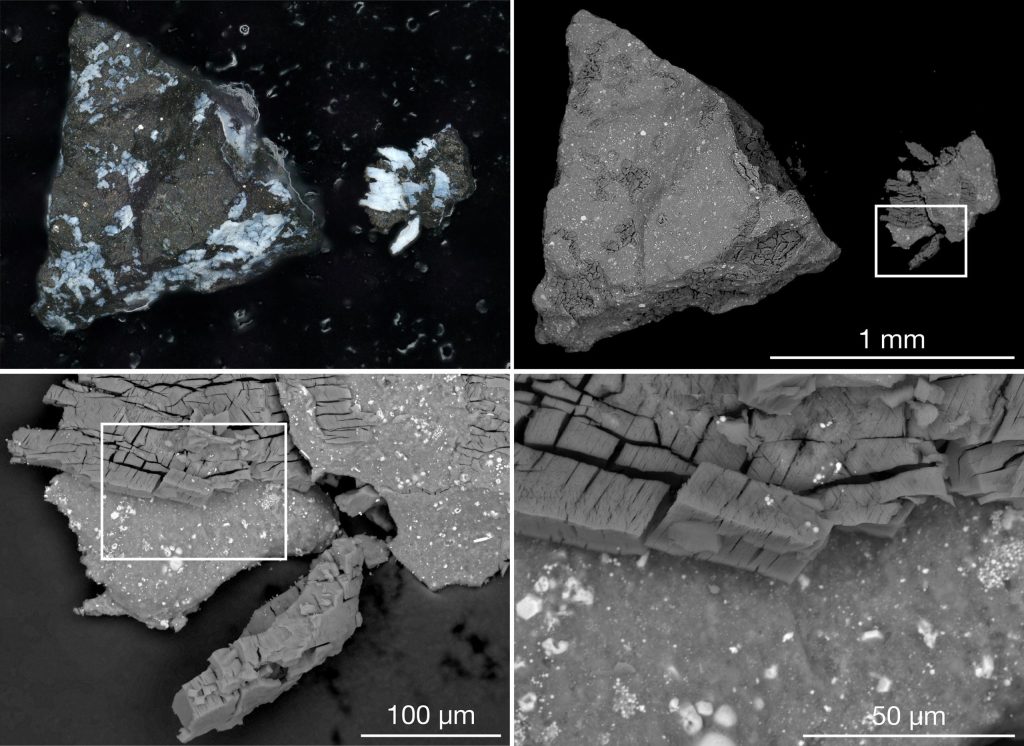A microscope image of a dark Bennu particle about 1 millimeter long with a bright phosphate shell. On the right is a smaller piece that has broken away. Source: Lauretta & Connolly et al. (2024) Meteoritics & Planetary Science, doi:10.1111/maps.14227
National Aeronautics and Space Administration (NASA)of Osiris Rex The mission returned samples from the asteroid Bennu that revealed they contained important materials from the solar system and traces of the possible existence of water in the past, a discovery that provides valuable insights into conditions in the early solar system and the possible origin of life.
Detailed examination of rock and dust samples returned from the near-Earth asteroid Bennu by NASA’s OSIRIS-REx mission led by the University of Arizona has revealed some long-awaited surprises.
Bennu contains the original ingredients that formed our solar system, the OSIRIS-REx sample analysis team found. The asteroid’s dust is rich in carbon, nitrogen, and organic compounds, all essential ingredients for life as we know it. The samples also contained sodium magnesium phosphate, which was surprising to the research team because it had not been seen in the remote sensing data the spacecraft collected at Bennu. The presence of sodium magnesium phosphate in the samples suggests that the asteroid may have broken off from a small, pristine ocean world that disappeared long ago.
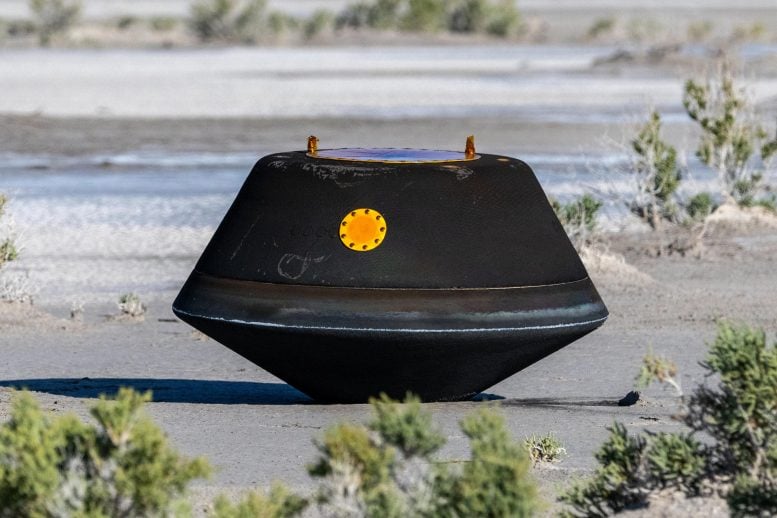
The sample return capsule of NASA’s OSIRIS-REx mission is pictured shortly after landing in the desert at the Department of Defense’s Utah Test and Training Range on Sept. 24, 2023. The sample was collected from asteroid Bennu by NASA’s OSIRIS-REx spacecraft in October 2020. Credit: NASA/Keegan Barber
Bennu sample journey and delivery
Launched on September 8, 2016, the Origins Spectral Interpretation, Resource Identification, Security and Regolith Probe, called OSIRIS-REx, began its journey to the near-Earth asteroid Bennu to collect samples of surface rocks and dust. OSIRIS-REx was the first U.S. mission to take samples from an asteroid. The probe is due to deliver the sample, weighing 4.3 ounces (121.6 grams), to Earth on September 24, 2023.
“We’re excited that after so many years we finally have the opportunity to take a closer look at the OSIRIS-REx sample from Bennu,” said Osiris Rex “This groundbreaking discovery not only answers long-standing questions about the early solar system, but also opens up new avenues of inquiry into the formation of Earth as a habitable planet,” said Dr. Gregory, Director of Planetary Sciences at the University of Arizona’s Lunar and Planetary Institute. “The insights outlined in the paper stimulate further curiosity and spur an eagerness to explore deeper.”
Lauretta is Meteoritics and planetary science A paper detailing the properties of the asteroid sample. This paper was Bennu Sample Catalogis an online resource where information about samples is made public and scientists can request sample material for their own research.
“The publication of the first paper on Bennu samples led by Dr. Lauretta and Dr. Connolly marks a milestone for the mission and for the Lunar and Planetary Institute,” said Mark Murray, director of the University of Arizona’s Lunar and Planetary Institute and chair of the Department of Planetary Sciences. “Our faculty, scientists and students will continue to study this sample for decades to come. For now, we can only imagine what the Bennu particles already in our lab will tell us about the origins of our planet and the life that inhabits it.”
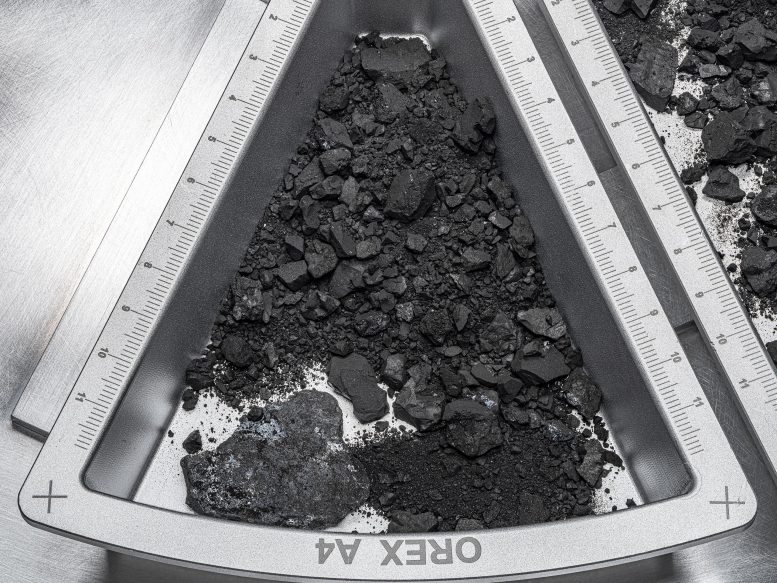
A top-down view of one of the rock and dust containers from asteroid Bennu. Hardware scales are in centimeters. Credit: NASA/Erika Blumenfeld and Joseph Aebersold
Bennu’s “watery past”?
Analysis of the Bennu samples has revealed intriguing insights into the asteroid’s composition: Samples dominated by clay minerals, particularly serpentine, reflect the types of rocks found at Earth’s mid-ocean ridges, where material from the mantle, the layer beneath Earth’s crust, comes into contact with water.
This interaction of seawater with material from Earth’s mantle forms clays, which in turn produce a variety of minerals, including carbonates, iron oxides, and iron sulfides. But the most unexpected finding in Bennu’s samples, Lauretta says, is the presence of water-soluble phosphates. These compounds are building blocks of the biochemistry of all life currently known on Earth.
Similar phosphates have been found in samples from the asteroid Ryugu, delivered by the Japan Aerospace Exploration Agency’s (JAXA) Hayabusa2 mission in 2020. But the sodium magnesium phosphate detected in the Bennu sample stands out because it lacks tiny bubble-like inclusions of other minerals trapped in the rock, and because its grain size is unprecedented for a meteorite sample, Lauretta said.
The discovery of sodium magnesium phosphate in Bennu samples raises questions about the geochemical processes that assembled these elements and provides valuable clues about Bennu’s historical conditions.
“The presence and state of phosphates on Bennu, along with other elements and compounds, suggest that the asteroid was once rich in water,” Lauretta said. “Bennu may have once been part of a wetter world, although this hypothesis requires further investigation.”
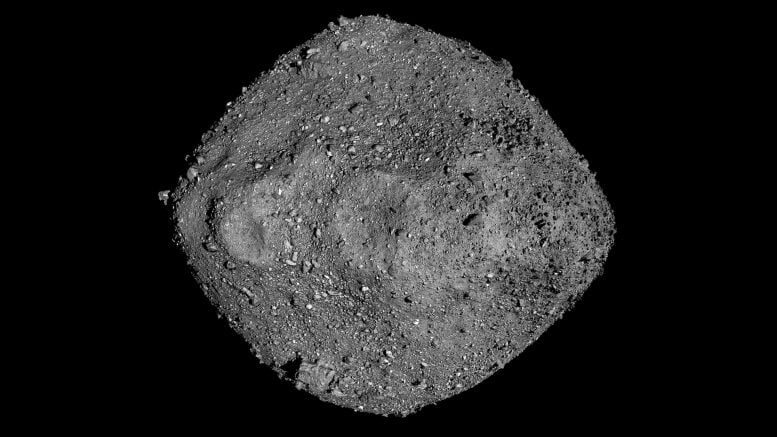
This mosaic of Bennu was created using observations from NASA’s OSIRIS-REx spacecraft, which flew close to the asteroid for more than two years. Credit: NASA/Goddard/University of Arizona
From the young solar system
Although Bennu may have interacted with water, it is a chemically primitive asteroid, with elemental ratios very similar to those of the Sun.
“The samples we brought back represent the largest repository of unaltered asteroid material currently on Earth,” Lauretta said.
The asteroid’s composition offers a glimpse into the early days of our solar system more than 4.5 billion years ago. The rocks remain pristine without having melted or resolidified since their formation, confirming their pristine nature and ancient origin.
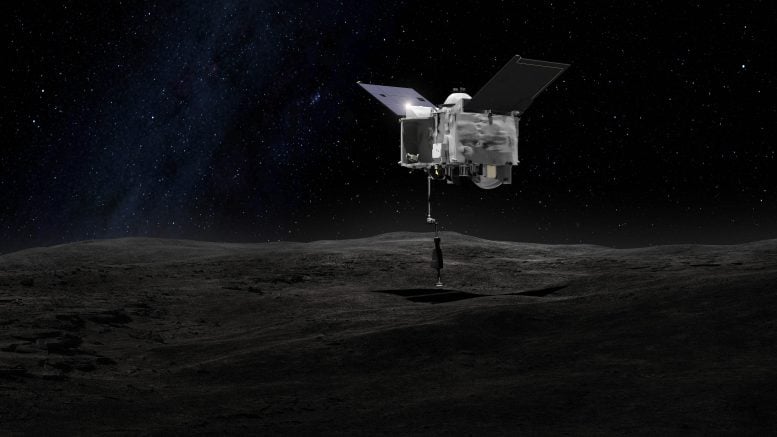
This artist’s rendering shows the OSIRIS-REx spacecraft using its Touch-and-Go Sample Arm Mechanism (TAGSAM) to contact the asteroid Bennu. The mission successfully returned a sample of Bennu’s surface coating to Earth for study. Credit: NASA
Hints at the building blocks of life
The team also found that the asteroid is rich in carbon and nitrogen — elements that are crucial for understanding the environments in which Bennu’s material originated and the chemical reactions that transformed simple elements into complex molecules that may have laid the foundation for life on Earth.
“These discoveries highlight the importance of collecting and studying material from asteroids like Bennu, especially the low-density material that would burn up upon entering Earth’s atmosphere,” Lauretta said. “This material holds the key to unlocking the complex processes of the formation of our solar system and pre-biotic chemistry that may have contributed to the emergence of life on Earth.”
What’s next?
Dozens of laboratories in the U.S. and around the world are expected to receive portions of Bennu samples from NASA’s Johnson Space Center in Houston in the coming months, and many more scientific papers describing Bennu samples are expected to be published by the OSIRIS-REx sample analysis team in the coming years.
“The Bennu samples are mesmerizingly beautiful extraterrestrial rocks,” said Harold Connolly, co-first author of the paper, mission sample scientist who leads the sample analysis team, and is a professor at Rowan University in Glassboro, N.J., and visiting research scientist at the University of Arizona. “Every week, analyses by the OSIRIS-REx sample analysis team provide new, sometimes surprising, discoveries that help impose important constraints on the origin and evolution of Earth-like planets.”
Reference: “Asteroid (101955) Bennu in the Laboratory: Characterization of Samples Collected by OSIRIS-REx” by Dante S. Lauretta, Harold C. Connolly, Joseph E. Aebersold, Conel M. O’D. Alexander, Ronald-L.Balouse, Jessica J. Burns, Helena C. Bates, Karina A. Bennett, Laurine Blanche, Erica H. Blumenfeld, Simon J. Clemmett, George D. Cody, Daniella N. DellaGiustina, Jason P. Dworkin, Scott A. Eckley, Dionysis I. Foustoukos, Ian A. Franchi, Daniel P. Glavin, Richard C. Greenwood, Pierre Henécourt, Victoria E. Hamilton, Dolores H. Hill, Takahiro Hiroi, Kana Ishimaru, Fred Jordan, Hannah H. Kaplan, Lindsay P. Keller, Ashley J. King, Piers Coford, Me. Lissa K. Kontogiannis, Loan Le, Robert J. Macke, Timothy J. McCoy, Ralph E. Milliken, Jens Najorká, Anh N. Nguyen, Maurizio Pajola, Anjani T. Pollitt, Kevin Wright, Heather L. Roper, Sarah S. Russell, Andrew J. Ryan, Scott A. Sandford, Paul F. Schofield, Cody D. Schultz, Laura B. Seifert, Tachibana Shogo, Cathy L. Thomas Keprta, Michelle S. Thompson, Valerie Tu, Filippo Tusberti, Kun Wang, Thomas J. Zega, CWV Wallner, 26 June 2024, Meteoritics and planetary science.
DOI: 10.1111/maps.14227


